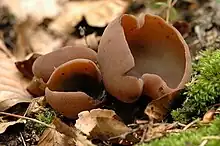| Legaliana badia | |
|---|---|
 | |
| Scientific classification | |
| Domain: | Eukaryota |
| Kingdom: | Fungi |
| Division: | Ascomycota |
| Class: | Pezizomycetes |
| Order: | Pezizales |
| Family: | Pezizaceae |
| Genus: | Legaliana |
| Species: | L. badia |
| Binomial name | |
| Legaliana badia (Pers.) Van Vooren, 2020 | |
| Synonyms | |
| |
Legaliana badia is a species of apothecial fungus belonging to the family Pezizaceae. This is one of the more familiar of the cup fungi of Europe, appearing as irregular dark brown cups up to 8 cm in diameter, often in small groups, on soil in woodland. The species tends to be seen more frequently on sandy soils and favours bare ground, e.g. at the sides of paths. This is a frequently observed European species with scattered records from many other parts of the world. It is not edible.[1]
References
Further reading
- Jordan, Michael (2004). The Encyclopedia of Fungi of Britain and Europe. Frances Lincoln Publishers. p. 45. ISBN 978-0-7112-2379-0.
- Buczacki, Stefan (1992). Collins Guide to Mushrooms and Toadstools of Britain and Europe. HarperCollins. p. 217. ISBN 0-00-219978-5.
This article is issued from Wikipedia. The text is licensed under Creative Commons - Attribution - Sharealike. Additional terms may apply for the media files.